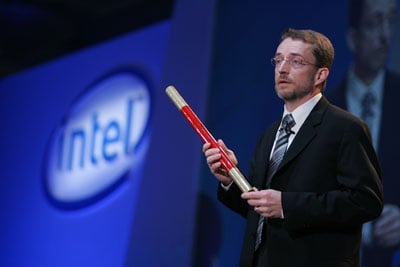This article is more than 1 year old
Can the Atom help Intel's CEO meet otherworldly demands?
Otellini bullish on MIDs, bearish on Affymetrics
The immense costs associated with building semiconductor plants continues to take a toll on some of the technology industry's biggest names. Texas Instruments, where Jack Kilby invented the integrated circuit (hats off to Noyce as well), has opted to bail out on the 32nm endeavor. Meanwhile, the Japanese giants form as many partnerships as possible around sharing research and production costs, and IBM tries to bring on as many customers/partners as it can. The fabrication set in Taiwan face similar cost issues and must keep their factories full while staying on top of the latest and greatest processes.
In many ways, this pushes Intel more and more toward a world where it's the only vendor able to compete as an independent.
"Samsung, TSMC and Intel are certainly maintaining the integrated production model, although TSMC's output is really obviously foundry driven," Otellini said. "They are not finding the need to partner to develop future technology or to share capacity."
[We believe Samsung does in fact have a 32nm deal in place with IBM and Chartered - Ed]
"This is just economics. If you are going to build to a world-class scale, in order to recoup that $4bn-$5bn investment at reasonable margins, one needs to have revenue in the range of $5bn-$6bn a year coming out of that factory. There aren't many semiconductor companies with revenue greater than $5bn-$6bn."
"From our perspective, those types of sharing arrangements are sub-optimal. We like to optimize product and process technology for each other."
Otellini points to notebook chips as one area where Intel wanted to feed a growing market with as many chips as possible and was forced to confront power issues head-on in order to deliver competitive products. This pushed Intel to jump to a new substrate - Hafnium - earlier than it might have expected. As a result, the company's entire processor line benefited.
One could argue that competitors such as Transmeta also pushed Intel in the low-power direction and that such rivals seem less likely to appear moving forward due to the costs of playing in the semiconductor game. The foundry model does present start-ups with a nice option for reaching production scale without investing in fabs. But we've seen companies such as Transmeta, PA Semi and even the yet to de-stealth Montalvo Systems struggle to compete against Intel's - and to a lesser degree AMD's - stranglehold on the x86 laptop, PC and server chip markets. These start-ups can conjure up technical edges over Intel, but such gains seem near impossible to achieve and short-lived when they do occur. Doesn't a lack of competition threaten to make Intel complacent in these mainstream markets and also to raise more potential anti-trust issues for the company?

Intel VP Pat Gelsinger discusses his engineer superpowers
"There is nothing against the law about being better than another company," Otellini said. "In fact, that is the nature of technology.
"I have done this for over three decades. Technical leads are transient. You can be disrupted by your own new products. You can be disrupted by somebody else's new products.
"I don't have sleepless nights worrying about lack of competition. Like I said, I have been doing this for three decades, and there has always been someone nipping at our heels."
From Jello to DARPA
I closed out the conversation with Otellini by looking at one area where Intel faces plenty of innovative competition - supercomputing.
The Defense Department tends to fund some of the most interesting machines going, and Intel has failed to win or even be part of many of the large, recent handouts. IBM and Cray, for example, split a massive award around large-scale systems and will rely on Power and a mix of Opterons and accelerators, respectively. In addition, the biggest machines coming up this year in the US will run on Opteron chips.
Otellini, however, said that Intel does in fact have something in store with DARPA.
"Watch this space," he told us.
But what exactly is Intel's relationship like with DARPA?
"We have participated in those kinds of deals in the past. In the old days, we actually built a supercomputer and sold one to Sandia. But nowadays those contracts tend to be best fulfilled through OEMs. So, they are still interesting to us and watch that space."
But I haven't seen a large contract announ. . . .
"I am not going to go there."
Ah, well, I tried.
Sun, IBM, HP, Dell? Bueller? Bueller? Bueller? Go on, boys, you know where to send the e-mail.
And with that, our Otellini moment came to an end. The marketing guy. The sales guy. The guy expected to meet deity-level standards said goodbye and dashed out of the conference room.
"How do you like that," I thought. Last time I'd been in that office, no less than Gordon Moore took me a on personal tour of his double-wide cubicle and then walked me out of the Robert Noyce Building. This time around, I was escorted off the premises by a Greek henchman.
But, you know, those engineering types have a bit more polish than the marketing guys. ®
